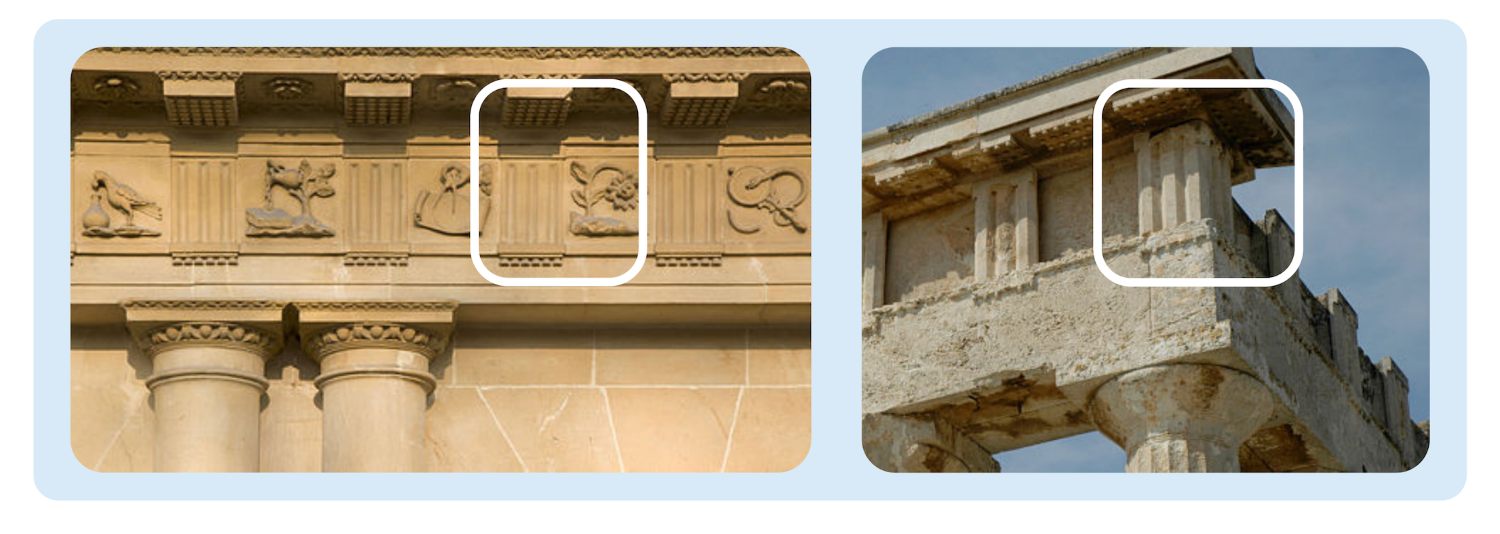Contemporary architects and designers sometimes choose to draw on elements of style that reference the work of ancient builders, dating back thousands of years ago, such as the stone and marble remains of Greek and Roman structures. In turn, those remains preserve the references that ancient architects made to their own heritage.

The triglyph depicted in the previous image is a common design pattern that you could easily identify on many public and private buildings in your area. This pattern of three vertical posts separated by grooves, is an example of a skeuomorphic expression--a stylistic, but otherwise non-essential element that stands for an original element, which was functionally essential to the structure. In the case of the triglyph, the stone depiction serves as an ornamental reference to the endings of long, massive wooden beams that used to support the roofs of buildings.
Early architypes of the triglyph pattern can be found in the remains of Greek temples and Roman structures dating 2000 years ago. The builders of those ancient buildings used stone and marble as the primary construction material, but they wanted to preserve the glory and symbolic essence of wooden religious and cultural structures that were perhaps lost to war and fire (see the following images A and B).

Skeuomorphism, then, is a purely visual, non-functional form of design that is used as a means to preserve the meaning and experience of an earlier function. Steve Jobs was really fond of skeuomorphic design. In his opinion, software objects that resembled objects in the real world were easier and more intuitive for people to interact with.
Skeuomorphic design used to be popular in user interfaces of audio-visual editing software that referenced analog mixing consoles. The latter, such as the one depicted in the preceding image A, had rows upon rows of buttons controlling the mix of each sound channel.
When editing software became available, user experience designers attempted to provide sound technicians and musicians with a familiar look and feel, which they could do with the skeuomorphic representation in B. This experience was important because the users who transitioned from analog to digital, brought with them a wealth of expertise, and skeuomorphic design made the transition to new tools faster and more efficient because interface elements were easily recognizable.
In skeuomorphic design, we find a tension between a desire to preserve old experiences in new technologies, and an opportunity to create entirely new ones. These days, most musicians and sound engineers start editing directly in software products, using their computers or smartphones. Such users no longer have the need for or the experiential connection to the giant original analog consoles. For them it is no longer important to preserve any visual references to that equipment.

The implication is that there are opportunities to simplify the user interface and make the experience of editing simpler and more productive. Similarly, the interface of many analog products reflects design decisions that solved physical hardware needs no longer relevant in the digital domain. The rotary phone in image A above, is a good example of a common user experience that virtually disappeared when the dial was replaced with buttons that improved the speed of inputting the phone number.
Turning a full circle, however, product designers sometimes use skeuomorphism as a means to introduce fun and delight to the user experience by incorporating options that let users select a retro look for their user interface, such as the phone app in image B.
